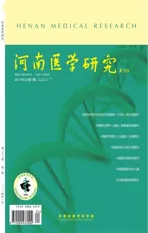三阴性乳腺癌相关基因的研究进展
2014-04-01李晓旭高艳丽李孟圈
李晓旭,高艳丽,李孟圈,许 瀚
(1.郑州大学第一附属医院乳腺外科 河南郑州 450052;2.郑州市卫生学校药理教研室 河南郑州 450005)
乳腺癌是女性常见的恶性肿瘤之一,是一种异质性较高的恶性肿瘤。Perou等[1]通过采用 cDNA微阵列技术将乳腺癌分成导管A型、导管B型、人表皮生长因子受体(Her-2)过表达型和基底样(Basal-like)型。Bryan等[2]首次明确提出了三阴性乳腺癌(triplenegative breast cancer,TNBC)的概念,即雌激素受体(estrogen receptor,ER)、孕激素受体(prog-esterone receptor,PR)和Her-2表达均为阴性的一种特殊类型的乳腺癌。近年来,随着医疗水平的不断提高,乳腺癌相关基因的研究越来越深入,基因表型分析领域的研究成果为TNBC的治疗和预后评估提供了很大帮助,本文将对TNBC相关基因的研究进展进行综述。
1 TNBC的特点及基因分型
1.1 TNBC的特点 TNBC约占所有乳腺癌的15%。侵袭性较强,分化程度较低,常有家族史[3]。Carey等[4]研究发现,50岁以下美国非洲裔妇女发病率可高达39%。另有研究显示,TNBC患者中肥胖者占49.6%,非TNBC女性中肥胖者仅占35.8%,推测肥胖女性更易患TNBC[5]。TNBC预后较差,复发及远处转移发生率较高。
1.2 TNBC的基因分型 按基因表型将TNBC分为6型:基底样细胞样型1(basal-like1,BL1),基底样细胞样型 2(basal-like 2,BL2),间质型(mesenchymal,M),免疫调节型(immunomod-ulatory,IM),腔上皮雄激素受体型(luminal and rogen receptor,LAR)和间质干细胞样型(mesenchymal stem-like,MSL)。BL1型和BL2型多高表达DNA损伤修复基因;M型和MSL型多为间质表现,大量免疫细胞浸润和低表达细胞-细胞连接蛋白;IM多高表达型免疫应答基因;LAR型则表达雄激素受体。6种分型TNBC的无复发生存(RFS)并不一致[6]。通过对TNBC进行基因分型,可以帮助判断TNBC的预后和寻找靶点,对TNBC的个体化治疗有重要意义。
2 TNBC相关基因
随着研究水平的提高,对于肿瘤发生机制的研究也逐步深入,TNBC相关基因逐渐被许多研究证实,为TNBC发生机制的阐明、指导治疗提供了重要价值。Wen等[7]分析51名TNBC患者的基因表达,45个TNBC复发和转移相关基因被筛选出来。Teschendorff等[8]首次报道了可以预测ER阴性乳腺癌患者预后的7个相关基因,并开发了7个基因表达分类预后工具。TNBC大多表达肌上皮标志物和细胞角质蛋白等,相较于非 TNBC,c-Kit、p53、Her-1(EGFR)等在 TNBC 中高度表达[9]。目前,研究较多的几个主要TNBC相关基因是 P53、CK5/6、BRCA1、Ki67、EGFR 等。
2.1 p53 p53是迄今为止发现的与肿瘤高度相关的基因之一,是具有广泛抑癌作用的重要基因,可抑制细胞增殖,促进细胞分化、凋亡和监测DNA损伤,TNBC中高度表达可至85%,且常发生 p53突变[10],p53突变后并不会阻止细胞增殖,可以导致异常的有丝分裂以及细胞死亡,从而致使肿瘤产生,研究发现MDM2是p53通路中重要的负反馈调节因子,因此p53是TNBC个体化治疗的重要突破口之一。
2.2 CK5/6 CK5/6为基底细胞型细胞角蛋白,在乳腺组织的腺中间细胞、定向干细胞、肌上皮中间细胞表达,在肌上皮终端细胞和腺上皮终端细胞则不表达。有研究认为,只凭借基底型CK在肿瘤细胞中表达就可以界定为basal-like型乳腺癌,而不需要其他的标志[11]。邓再兴等[12]研究发现 TNBC 中 CK5/6表达率达80.8%,再次证明basal-like型与TNBC的高度相关性,研究发现CK5/6阳性的TNBC的TNM分期较高、淋巴结转移率较高,而这些都与临床预后关系密切。
2.3 BRCA1 BRCA1定位于人类第17号染色体,是G/M期关键点调控因子,可通过激活Chkl激酶从而诱导阻滞G/M期修复损伤的DNA,还可控制细胞周期G/M期顺利进行中起重要作用的两种蛋白的表达来调节细胞周期,重新塑造染色质,并可调控基因转录。TNBC常伴有BRCA1突变,大约占30%,而TNBC在BRCA1突变的乳腺中所占比例高达90%,两者在表形特征及分子水平上有很多相似之处[13]。BRCA1是重要的抑癌基因,BRCA1基因突变使与其功能相关的基因序列发生变化,抑制肿瘤的功能丧失,致使乳腺癌发生[14]。因此BRCA1可以作为生物标记蛋白辅助诊断及治疗TNBC。
2.4 Ki67 Ki67是细胞增殖高相关的核抗原,随着细胞周期变化其抗原表达也发生变化。Gerdes等[15]研究发现 Ki67表达于 G1、S、G2、M 期,不表达于 G0期,研究还发现Ki67微量表达于G1晚期/S早期,并聚集于S期,并且明显高表达于后半期,在有丝分裂的后期迅速降解或者抗原决定簇失去,所以很多学者认为Ki67可以有效的评价肿瘤细胞增值的活性[16],TNBC中Ki67的表达较癌旁周围正常组织明显升高[17-19],所以Ki67的表达对研究 TNBC的生物学特性、评价其危害性具有很重要的意义。
2.5 EGFR EGFR是Her家族成员,是原癌基因cerbB1表达产物,也被称作Her-1、ErbB1,位于细胞膜表面,通过与配体结合而激活,进而激活位于细胞内激酶通路,从而诱导细胞增殖,如发生突变或过表达都将导致肿瘤的发生。许多研究表明TNBC中EGFR过表达[20-22]。因此,在TNBC缺乏内分泌治疗和Her-2受体靶向治疗的情况下,EGFR信号通路靶向治疗的研究可能会成为TNBC个体化治疗新的突破。
3 TNBC基因靶向治疗
TNBC由于ER、PR及Her-2表达阴性,相对于其他乳腺癌缺乏特异治疗靶点。然而,EGFR在TNBC中过表达,针对该靶点的药物可能对TNBC有效,如抗EGFR抗体(西妥昔单抗)。Gholam等[23]采用西妥昔单抗联合紫杉醇治疗TNBC皮肤转移患者,疗效显著。铂类药物在TNBC治疗中有特殊作用,联合西妥昔单抗治疗乳腺癌亦有一定效果[24]。达沙替尼是一个口服多靶点抑制剂,Finn等[25]研究表明,TNBC细胞对达沙替尼具有高度敏感性。最近研究表明TNBC中CD109表达明显增强,可能成为一个潜在的药物靶点[26]。
4 结语
TNBC是一种侵袭性较强、预后较差、复发和转移较高的乳腺癌亚型,由于TNBC患者雌孕激素及Her-2受体均为阴性,相对缺乏药物治疗靶点,目前尚无明确的治疗指南和个体化治疗。近年来,对TNBC相关基因的研究越来越多,许多TNBC相关基因逐渐被发现。相信通过更深入的研究,能够探索出更多TNBC靶向治疗的潜在靶点,为该类乳腺癌患者的治疗带来希望。
[1]Perou C M,Sorlie T,Eisen M B,et al.Molecular portraits of human breast tumours[J].Nature,2000 ,406(6797):747-752.
[2]Bryan B B,Schnitt S J,Collins L C.Ductl carcinoma in situ with basal-like phenotype:a possible precursor to invasive basal-like breast cancer[J].Mod Pathol,2006,19(5):617.
[3]Dent R,Trudeau M,Pritchard K I,et al.Triple negative breast cancer:clinical features and patterns of recurrence[J].Clin Cancer Res,2007,13(15Pt1):4429-4434.
[4]Carey L A,Perou C M,Livasy C A,et al.Race,breast cancer subtypes,and survival in the Carolina Breast Cancer Study[J].JAMA,2006,295(21):2492-2502.
[5]Vona-Davis L,Rose D P,Hazard H,et al.Triple-negative breast cancer and obesity in a rural Appalachian population[J].Cancer Epidemiol Biomarkers Prev,2008,17(12):3319-3324.
[6]Lehmann B D,Bauer J A,Chen X,et al.Identification of human triple-negative breast cancer subtypes and preclinical models for selection of targeted therapies[J].J Clin Invest,2011,121(7):2750-2767.
[7]Kuo W H,Chang Y Y,Lai L C,et al.Molecular characteristics and metastasis predictor genes of triple-negative breast cancer:a clinical study of triple-negative breast carcinomas[J].PLoS One,2012,7(9):e45831.
[8]Teschendorff A E,Miremadi A,Pinder S E,et al.An immune response gene expression module identifies a good prognosis sub-type in estrogen receptor negative breast cancer[J].Genome Biol,2007,8(8):R157.
[9]Cleator S,Heller W,Coombes R C.Triple-negative breast canser:Therapeutic options[J].Lancet Oncol,2007,8(3):235.
[10]Korsching E,Packeisen J,Agelopoulos K,et al.Cytogenetical 2 treations and cytokeratin expression patterns in breast cancer:in tegrating a new model of breast differentiation into cytogenetic pathways of breast carcinogenesis[J].Lab Invest,2002,82(11):1525-1533.
[11]Rakha E A,EI-Sayed M E,Green A R,et al.Breast carcinoma with basal differentiation:a proposal for pathology definition based on basal cytokeratin expression[J].Histopathology,2007,50(4):434-438.
[12]邓再兴,俞文菊,朱凯.乳腺癌组织CK5/6与EGFR表达及其临床意义的研究[J].中华肿瘤防治杂志,2008,15(19):1477-1480.
[13]Friedman L S,Ostermeyer E A,Lynch E D,et al.The search for BRCA1[J].Cancer Res,1994,54(24):6374-6382.
[14]Uyei A,Peterson S K,Erlichman J,et al.Association between clinical characteristics and risk-reduction interventions in women who underwent BRCA1 and BRCA2 testing:a single-institution study[J].Cancer,2006,107(12):2745-2751.
[15]Dowsett M,Smith I E,Ebbs S R,et al.Prognostic value of Ki67 expression after short-term presurgical endocrine therapy for primary breast cancer[J].J Natl Cancer Inst,2007,99(13):167-170.
[16]Xu T,Zhu Y,Xiong Y,et al.Ki67 suppresses tumorigenicity and regulates G1/S transition of human hepatocellular carcinoma cells[J].Hepatology,2009,50(1):113-121.
[17]Bauer K R,Brown M,Cress R D.Descriptive analysis of estrogen receptor(ER)-negative,progesterone receptor(PR)-negative,and HER2-negative invasive breast cancer,the so-called triple-negative phenotype:a population-based study from the California Cancer Registry[J].Cancer,2007,109(9):1721-1728.
[18]李梅,姚乐,惠起源.Livin、Ki-67蛋白在胃癌中的表达及意义[J].现代肿瘤医学,2011,19(2):302-304.
[19]徐文,李景贺,金方方,等.肾细胞癌E-cad和 Ki-67的表达及临床意义[J].现代肿瘤医学,2010,18(9):1774-1777.
[20]Nielsen T O,Hsu F D,Jensen K,et al.Immanohistochemical and clinical characterization of the basal-like subtype of invasive breast carcinoma[J].Clin Cancer Res,2004,10(16):5367-5374.
[21]Laakso M,Loman N,Borg A,et al.Cytokeratin 5/14-positive breastcancer:true basal phenotype confined to BRCAl tumors[J].Mod Pathol,2005,18(10):1321-1328.
[22]Rakha E A,EI-Sayed M E,Green A R,et al.Breast careinoma with basal differentiation:aproposal for pathology definition based on basal cytokeratin expression [J].Histopathology,2007,50(4):434-438.
[23]Gholam D,Chebib A,Hauteville D,et al.Combined paclitaxel and cetuximab achieved a major response on the skin metastases of a patient with epidermal growth factor receptor-positive,estrogen receptornegative,progesterone receptor-negative and human epidermal growth factor receptor-2-negative(triple-negative)breast cancer[J].Anticancer Drugs,2007,18(7):835-837.
[24]Oliveras-Ferraros C,Vazquez-Martin A,López-Bonet E,et al.Growth and molecular interactions of the anti-EGFR antibody cetuximab and the DNA cross-linking agent cisplatin in gefitinib-resistant MDA-MB-468 cells:new prospects in the treatment of triple-negative/basal-like breast cancer [J].Int J Oncol,2008,33(6):1165-1176.
[25]Finn R S,Dering J,Ginther C,et al.Dasatinib,an orally active small molecule inhibitor of both the src and abl kinases,selectively inhibits growth of basal-type/“triple-negative”breast cancer cell lines growing in vitro [J].Breast Cancer Res Treat,2007,105(3):319-326.
[26]Hasegawa M,Moritani S,Murakumo Y,et al.CD109 expression in basal-like breast carcinoma[J].Pathol Int,2008,58(5):288-294.
